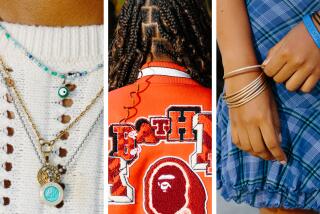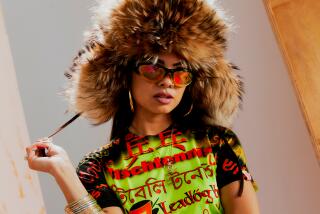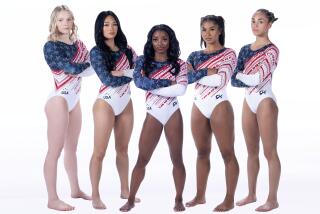Fashion 88 : Gifts for Men Who Work at Looking Good
If the men in your life are into outdoor sports, Christmas gift-giving just got easier. Until recently, says Douglas Brooks, author of “Going Solo: The Art of Personal Training” (Power Books, 1988), exercise fashion was limited to uniforms. But “uniforms don’t flatter or make anyone feel special.” And most people don’t feel good about working out until they look good.
For that reason, he continues, men involved in outdoor sports are now eager to make a fashion statement. “Looking good tells the world that the athlete is proud of himself and announces to his peers that his training is state of the art,” Brooks says.
Hip cyclists, for instance, gravitate toward clothes and accessories with fluorescent-bright colors, even though that look is miles from the traditional Tour de France outfit of black shoes, black pants and a colored jersey.
Colors Not Matched
“It doesn’t even matter if the colors don’t strictly go together,” says Brooks, who completed this year’s Ironman Triathlon aglow in neon. “A pink helmet, orange jersey, green gloves with terry cloth (to wipe sweat off the mouth) and blue biking shoes may seem a bit much. On the road, however, they look just fine.”
The ensemble can be further touched up by iridescent Oakley Razor or Rudi Project sunglasses and a lightweight, aerodynamic Giro helmet, available in a variety of interchangeable colors.
Beach volleyball players are also increasingly aware of style. Singin Smith, the world’s most successful professional beach player and, with his sisters and his brother, Andrew, the owner of Smithers Activewear, a Santa Monica store specializing in beach and volley fashion, believes that volley wear has replaced surfwear as the current activewear standard.
Smith, who is also a successful model, has developed the sport’s reigning look: This includes a cap with an upturned visor, wide volley shorts and black Body Glove shoulder and knee wraps (used to prevent inflammation and muscle soreness).
As with all true fitness fashion, each of these elements has functional origins. Smith started wearing the cap, for example, to keep the sun out of his eyes. Because it bothered him when he played, he got into the habit of flipping the visor up during games. Then he got the idea of printing his sponsor’s name on the visor to generate additional publicity. Now, he reports, “you see people wearing the upturned visor all the time.”
Since the knee and shoulder wraps are rehabilitative, no one wears them just because they like the way the wraps look. But because many players incur knee and shoulder injuries, the wraps were increasingly present. Body Glove added neon colors and a more fashionable cut and, at Smith’s suggestion, put in leather pads so they could be worn during play. By the end of last season’s pro tour, they were an integral part of the image.
The volley short, which updates the classic surf short, is also functional. To accommodate the volleyball players’ large quadricipital muscles, they are wider in the leg than conventional surf wear.
Unlike volleyball players, who tend to be clean-cut, skateboarders and roller skaters pursue a more radical image. Stacy Peralta, skateboard pioneer and director of the new skateboard video, “Public Domain,” reports that skateboarders prefer looking like “athletic pirates.”
This requires long shorts, T-shirts and an earring or two. Pulling it all together is a unique form of headgear made from the sleeve of a long-sleeve T-shirt. “You cut the sleeves off and wrap it on top of your head the way the Aunt Jemima character did. It is the greatest headband ever made, and the coolest of all skate looks,” Peralta says.
Roller skaters tend to be more eclectic. “We are still looking for a distinctive look,” says Chris Morris, captain of Team Rollerblades, a professional racing and exhibition team and a U.S. Ski Assn. ski racer. “To accentuate the musculature of the legs and buttocks, skaters wear volley or cycling shorts or tights and a blousey sweat or T-shirt on top.”
Perhaps because they are older and more safety conscious, roller skaters are more likely than skateboarders to accessorize their look with safety gear. Rector, a company that makes elbow pads, knee pads and wrist guards, has made this possible by introducing models in neon and other colors in addition to the traditional nondescript gear.
Even skiers, who were traditionally conservative, have brought the beach look to the slopes. To let their skiing speak for itself, good skiers love the new form-fitting outfits, such as those by North Face, which mix bright colors and new fabrics such as Gore-Tex. Skiers then dress the suits up with Day-Glo Bolle goggles, neon headbands, gloves, fanny packs and ski and boot totes.
As with the other sports, these accessories both influence and reflect a man’s attitude about his style and his sport. And if the look is put together well, it enables him to hold his own next to an elite athlete, at least until the gun goes off.






